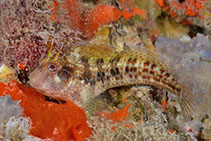| Family: |
Blenniidae (Combtooth blennies), subfamily: Salariinae |
| Max. size: |
|
| Environment: |
benthopelagic; marine |
| Distribution: |
Eastern Indian Ocean: Western Australia. |
| Diagnosis: |
Dorsal spines (total): 12; Dorsal soft rays (total): 15-17; Anal spines: 2; Anal soft rays: 16-18. Segmented dorsal fin rays 16 (rarely 15 or 17); segmented anal fin rays 18 (rarely 16-17); supraorbital tentacle comprised of a long, stout main tentacle bearing 3 to 9 (rarely 9) side branches; head lateral line system with 120 to 266 pores (mean 207.4); male Western Australian species with intense spotting on lower side of head; with round light brown blotch on postorbital region bordered by a typically segmented white, dark-edged streak; numerous medium to blackish brown blotches on lower half of cheek, sides of upper lip, suborbital area, branchiostegal membranes, pectoral fin base and basal 1/3 of pectoral fin; 6 to 7 groups of elongate rows of dark blotches on upper 2/3 of body. |
| Biology: |
Oviparous. Eggs are demersal and adhesive (Ref. 205), and are attached to the substrate via a filamentous, adhesive pad or pedestal (Ref. 94114). Larvae are planktonic, often found in shallow, coastal waters (Ref. 94114). |
| IUCN Red List Status: |
Least Concern (LC); Date assessed: 27 March 2009 Ref. (130435)
|
| Threat to humans: |
harmless |
| Country info: |
|
Source and more info: www.fishbase.org. For personal, classroom, and other internal use only. Not for publication.

